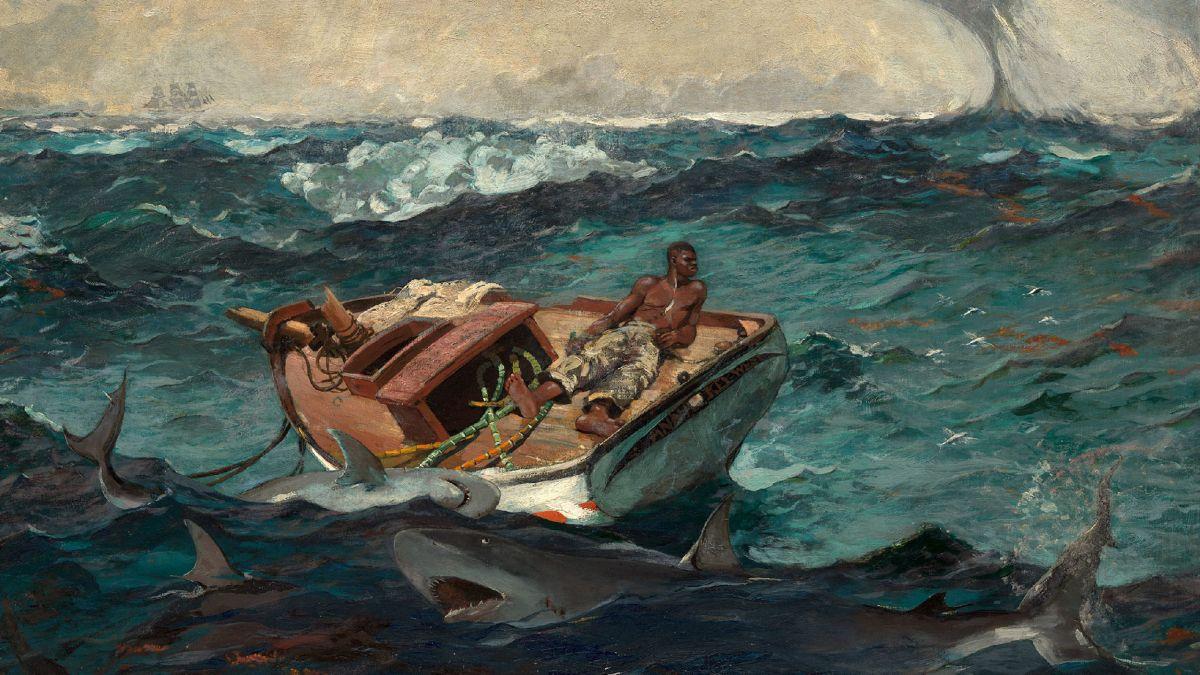Winslow Homer was an American painter, printmaker, and one of the leading figures in the art movement known as American Impressionism. He was born in Boston, Massachusetts, in 1836 and grew up in nearby Cambridge. Homer began his career as a commercial illustrator, working for magazines such as Harper’s Weekly and Scribner’s Monthly.
Many people consider Winslow Homer, the best American painter of the nineteenth century. He is well renowned for his depictions of coastal and rural life and his drawings of the American Civil War. The songs “Breezing Up (A Fair Wind),” “Snap the Whip,” and “The Gulf Stream” are among his most well-known masterpieces.
Homer, primarily self-taught, started his career as a commercial illustrator. He then began oil painting and produced significant studio pieces distinguished by the weight and density he derived from the medium. He also produced a flowing and prolific body of work using watercolor, primarily documenting his working holidays. Some of Winslow Homer watercolor paintings are the best he ever did, and we will examine the most significant works he did. Some of his famous paintings are listed below.
Table of Contents
The Life Line
The Life Line by Winslow Homer has gained popularity ever since it was published in 1884. Even though there are hints of a struggling sailing ship at the left, a fragmented and obscured view of a 19th-century breeches buoy and lifeline, and the corseted figure of the woman, Homer’s themes of human frailty, bravery, and romance in the context of the overwhelming power of nature remain timeless after more than a century.
In the painting, the woman is shown holding onto a rope attached to a life preserver, floating in the water next to the capsized boat. The man is shown reaching out toward the woman, trying to grab hold of the rope and help her to safety. The scene is depicted at sunset, with the sky and water glowing with a golden light.
The painting is notable for its dramatic composition and the sense of tension and danger it conveys. The woman’s body is stretched towards the life preserver, and her face is contorted with fear and desperation. The man’s body is also stretched, reaching toward the woman to save her. The capsized boat and the swirling water add to the sense of danger and instability.
Breezing Up (A Fair Wind)
“Breezing Up (A Fair Wind)” is a painting by Winslow Homer that depicts a group of boys sailing a small boat on a calm day. The painting is considered one of Homer’s most iconic works and is now in the collection of the National Gallery of Art in Washington, D.C.
The boys are shown sailing a small boat on a calm, sunny day in the painting. The boat is shown in the center of the composition, with the boys sitting on either side. The boat is pointed toward the viewer, and the boys are shown looking out toward the viewer as well. The sky is blue and clear, and the water is calm and reflects the sky.
One of the most notable aspects of the painting is the sense of joy and freedom it conveys. The boys are shown laughing and having a good time, and the boat is shown moving smoothly through the water. The clear sky and calm water contribute to the sense of serenity and peacefulness.
Overall, “Breezing Up (A Fair Wind)” is a joyful and uplifting painting that captures the freedom and possibility of spending a day on the water. It is a testament to Homer’s ability to convey strong emotions and capture the beauty of nature through his compositions.
The Gulf Stream
“The Gulf Stream” is a painting by the artist Winslow Homer that depicts a lone sailor adrift on a small boat during a raging storm. The painting is considered one of Homer’s most powerful works and is now in the National Gallery of Art collection in Washington, D.C.
The sailor is shown struggling to keep his small boat upright amid a fierce storm in the painting. The sky is dark and threatening, with clouds swirling overhead and lightning flashing in the distance. The water is rough and choppy, with waves crashing against the boat and drenching the sailor.
One of the most notable aspects of the painting is the sense of isolation and vulnerability. The sailor is shown alone in the small boat, with no one else in sight. The boat is tossed around by the storm, and the sailor struggles to keep it upright. The dark sky and rough water contribute to the sense of danger and uncertainty.
Snap The Whip
Winslow Homer painted a scene of youngsters playing “snap the whip” on a grassy field in his painting “Snap the Whip.” The picture, which is now in the collection of the Metropolitan Museum of Art in New York, is regarded as one of Homer’s most well-known pieces.
The boys are depicted in the artwork playing the game of “snap the whip,” in which they line up and hold hands with each other. The boys are then sent flying over the meadow after the line snaps. The view is shown on a bright day with a blue sky and green grass.
One of the most notable aspects of the painting is the sense of energy and motion it conveys. The boys are shown running and tumbling across the grass, with their bodies stretched out and their legs and arms moving. In addition, the vibrant colors and the sense of light in the painting contribute to the sense of joy and excitement.
Overall, “Snap the Whip” is a lively and energetic painting that captures the fun and freedom of playing outdoors. It is a testament to Homer’s ability to convey strong emotions and capture the joy of childhood through his compositions.
The Fog Warning
A fisherman on a small boat pulls in his net as fog rolls in Winslow Homer’s painting “The Fog Warning.” The artwork, which is now kept in the collection of the National Gallery of Art in Washington, D.C., is regarded as one of Homer’s most illustrious creations.
The fisherman is depicted working in a small boat in the picture as a dense fog approaches. His arms and back muscles are revealed to be strained as he pulls in his net. It feels even more desolate and lonely because the sea is rough and the sky is cloudy.
The painting’s sense of isolation and tenacity is among its most remarkable features. The fisherman is pictured working alone, with no other people in view. He is concentrated on his task and is not bothered by the choppy water or the fog. The rough ocean and cloudy sky add to the feeling of peril and suffering.
The sense of isolation and tenacity that can come with laboring at sea is captured in “The Fog Warning,” a strong and haunting painting. It is evidence of Homer’s talent for evoking intense feelings and capturing nature’s roughness and beauty in his compositions.
Conclusion
Winslow Homer was an accomplished and well-respected painter and printmaker who became famous for his frank and vivid representations of rural and seaside life. His paintings stand out for their powerful compositions, rich colors, and capacity to evoke deep emotions. Art lovers worldwide continue to adore and research these works of art, which are thought to be some of the best examples of American Impressionism. If you want to learn about Winslow Homer, you can read more about him here on our blog.
Also, Read – House Party Gadgets That You Need to Have




